Psyche: NASA Mission to a Metal World

When our solar system was very young, there were no planets-only a diffuse disk of gas and dust circled the sun. But within a few million years, that churning cloud of primordial material collapsed under its own gravity to form hundreds, or maybe thousands, of infant planets. Some of those planetesimals, as astronomers call them, grew to be hundreds of kilometers across as they swept up more dust and gas within the swirling solar nebula.
Once they had attained such a size, heat from the decay of the radioactive elements within them became trapped, raising temperatures enough to melt their insides. The denser components of that melt-iron and other metals-settled to the center, leaving lighter silicates to float up toward the surface. These lighter materials eventually cooled to form mantles of silicate rock around heavy metallic cores. In this way, vast amounts of iron and nickel alloys were trapped deep inside these planetesimals, forever hidden from direct scrutiny.
Or were they?
At this time, the solar system was still relatively crowded despite its vast size. And over the next 20 million or so years, many planetesimals crossed paths and collided. Some merged and grew into even larger protoplanets, eventually forming what became the familiar planets we know today.
In each of those protoplanet collisions, the metallic cores were battered and remixed with silicate mantle material, later separating again after being melted by the heat of accretion. Some collisions had enough energy to completely obliterate a protoplanet, leaving behind debris that contributed to the asteroid belt that now exists between the orbits of Mars and Jupiter.
But a few protoplanets may have escaped either of these fates. Astronomers hypothesize that a series of hit and run" impacts caused these bodies to lose most of their mantles, leaving behind only a small quantity of silicate rock and a large amount of metal. These materials combined to form a rare kind of world. If this theory is correct, the largest example would be an asteroid called 16 Psyche-named after the Greek goddess of the soul, Psyche, and because it was the 16th member of the asteroid belt to be discovered (in 1852).
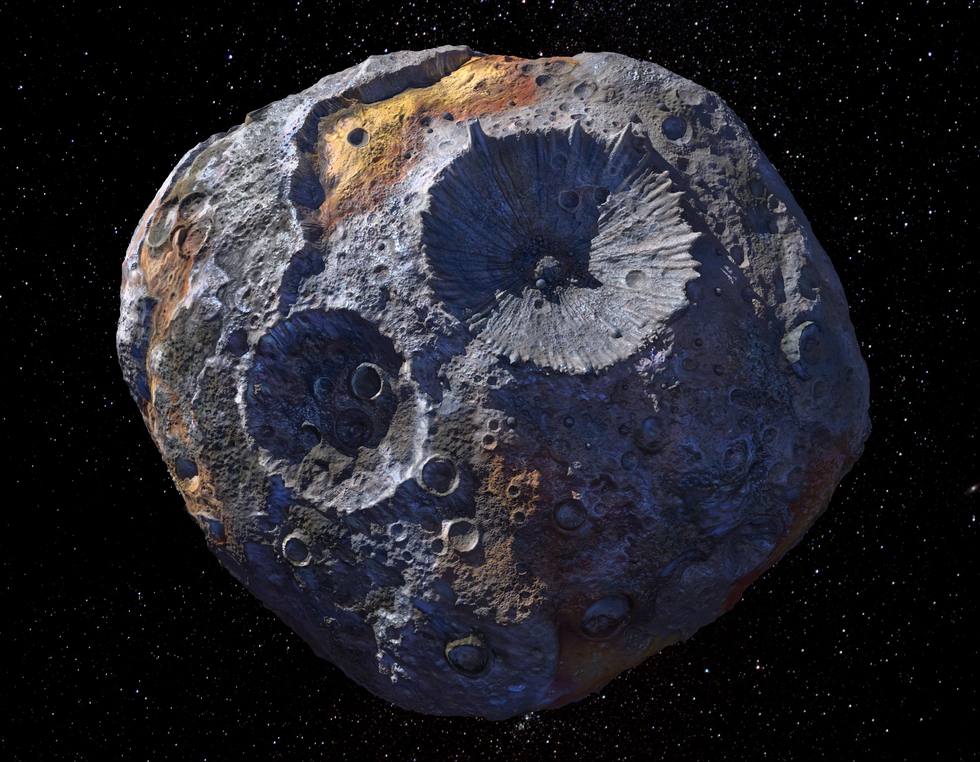 This artist's rendering suggests the kind of surface the asteroid 16 Psyche might have.Peter Rubin/JPL-Caltech/Arizona State University/NASA
This artist's rendering suggests the kind of surface the asteroid 16 Psyche might have.Peter Rubin/JPL-Caltech/Arizona State University/NASA
16 Psyche is about as wide as Massachusetts and has metal-like density. This makes it large and dense enough to account for a full 1 percent of the total mass of the asteroid belt. Metal miners of the future may one day stake claims on it.
Psyche is also the name of a NASA mission to visit that asteroid. Led by Lindy Elkins-Tanton of Arizona State University and managed by NASA's Jet Propulsion Laboratory, the Psyche mission will test astronomers' theories about planetary-core formation and composition while it explores a world with a landscape unlike any that space probes have visited so far.
 Lindy Elkins-Tanton of Arizona State University leads the Psyche mission's scientific team.Bill Ingalls/NASA
Lindy Elkins-Tanton of Arizona State University leads the Psyche mission's scientific team.Bill Ingalls/NASA
The Psyche mission is scheduled to launch in August 2022, with the spacecraft reaching its destination more than three years later. What will it find there? Astronomers think we might see enormous surface faults from the contraction of freezing metal, glittering cliffs of green crystalline mantle minerals, frozen flows of sulfur lava, and vast fields of metal shards scattered over the surface from millennia of high-speed impacts. There will no doubt be plenty of surprises, too.
The long journey this space probe must make to reach its destination will be especially demanding. 16 Psyche resides in the outer part of the main asteroid belt, well beyond the orbit of Mars. The probe will begin circling the asteroid in January of 2026 and will study it for nearly two years.
Counterintuitively, arranging for a probe to orbit a small body like an asteroid is harder than orbiting a planet. Big planets have deep gravity wells, which allow spacecraft to enter orbit with a single low-altitude rocket burn. Small bodies have little gravity and provide essentially no gravitational leverage, so the spacecraft's propulsion system must do all the work.
Astronomers think we might see enormous surface faults, glittering cliffs of green crystalline mantle minerals, frozen flows of sulfur lava, and vast fields of metal shards.
Not long ago, NASA managed this maneuver successfully with its Dawn mission, which sent a probe to orbit the asteroids Vesta and Ceres. The Dawn spacecraft used solar-electric propulsion. Its three highly efficient engines converted electricity from solar arrays into thrust by ionizing a propellant gas and accelerating it though a high-voltage electric field.
When our team at the Jet Propulsion Laboratory was designing the Psyche probe, we planned to do something similar. The main problem was figuring out how to do it without exceeding the mission's budget. JPL engineers solved this problem by using what was for the most part existing technology, manufactured by Maxar, a company based in Westminster, Colo. It is one of the world's largest providers of commercial geosynchronous communication satellites, produced at a division located in Palo Alto, Calif.
The Psyche spacecraft is built on the chassis" used for those satellites, which includes high-power solar arrays, electric-propulsion thrusters, and associated power and thermal control elements. In many ways, the Psyche spacecraft resembles a standard Maxar communications satellite. But it also hosts JPL's avionics, flight software, and the many fault-protection systems required for autonomous deep-space operation.
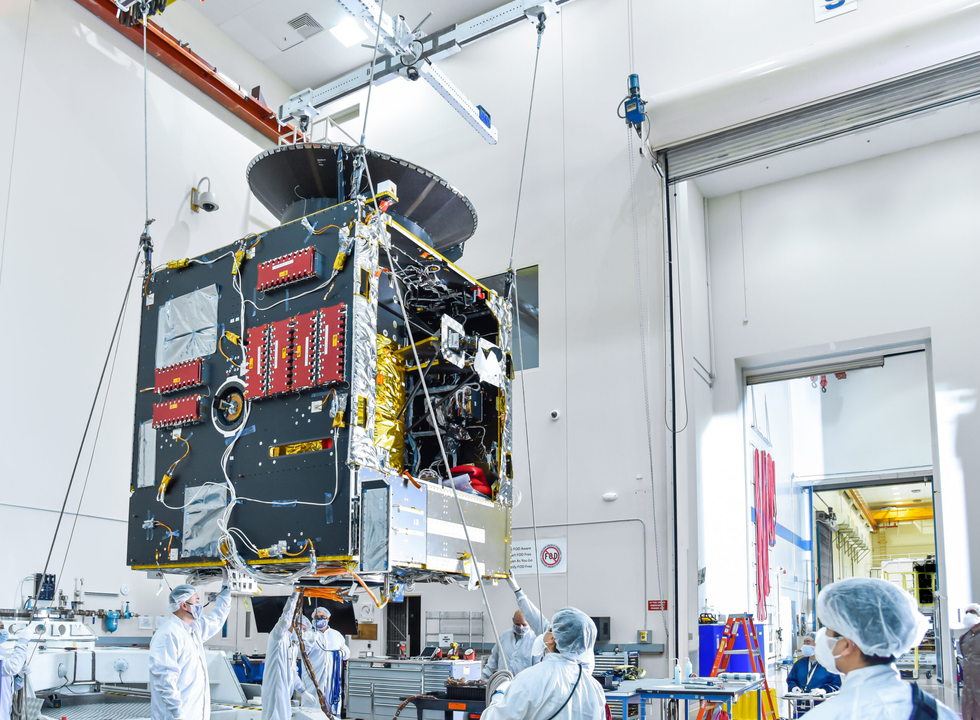 Technicians at NASA's Jet Propulsion Laboratory work on the Psyche spacecraft.Maxar
Technicians at NASA's Jet Propulsion Laboratory work on the Psyche spacecraft.Maxar
Making this concept work was difficult from the get-go. First, NASA management was rightfully wary of such cost-cutting measures, because the faster, better, cheaper" model of missions mounted in the 1990s produced some spectacular failures. Second, using Earth-orbiting systems on the Dawn mission resulted in large cost overruns during the development phase. Finally, many people involved believed (erroneously) that the environment of deep space is very special and that the Psyche spacecraft would thus have to be very different from a communications satellite intended only to orbit Earth.
We and our many NASA colleagues addressed each of these issues by teaming with engineers at Maxar. We kept costs under control by using hardware from the company's standard product line and by minimizing changes to it. We could do that because the thermal environment in geosynchronous orbit isn't in fact so different from what the Psyche probe will encounter.
Soon after launch, the Psyche spacecraft will experience the same relatively high solar flux that communications satellites are built for. It will also have to handle the cold of deep space, of course, but Maxar's satellites must endure similar conditions when they fly through Earth's shadow, which they do once a day during certain times of the year.
Because they serve as high-power telecommunications relays, Maxar's satellites must dissipate the many kilowatts of waste heat generated by their microwave power amplifiers. They do this by radiating that heat into space. Radiating lots of heat away would be a major problem for our space probe, though, because in the vicinity of 16 Psyche the flux of light and heat from the sun is one-tenth of that at Earth. So if nothing were done to prevent it, a spacecraft designed for orbiting Earth would soon become too cold to function this far out in the asteroid belt.
Maxar addressed this challenge by installing multilayer thermal blanketing all over the spacecraft, which will help to retain heat. The company also added custom louvers on top of the thermal radiators. These resemble Venetian blinds, closing automatically to trap heat inside when the spacecraft gets too cold. But plenty of other engineering challenges remained, especially with respect to propulsion.
To reduce the mass of propellant needed to reach the asteroid, the Psyche spacecraft will use solar-electric thrusters that accelerate ions to very high velocities-more than six times as high as what can be attained with chemical rockets. In particular, it will use a type of ion thruster known as a Hall thruster.
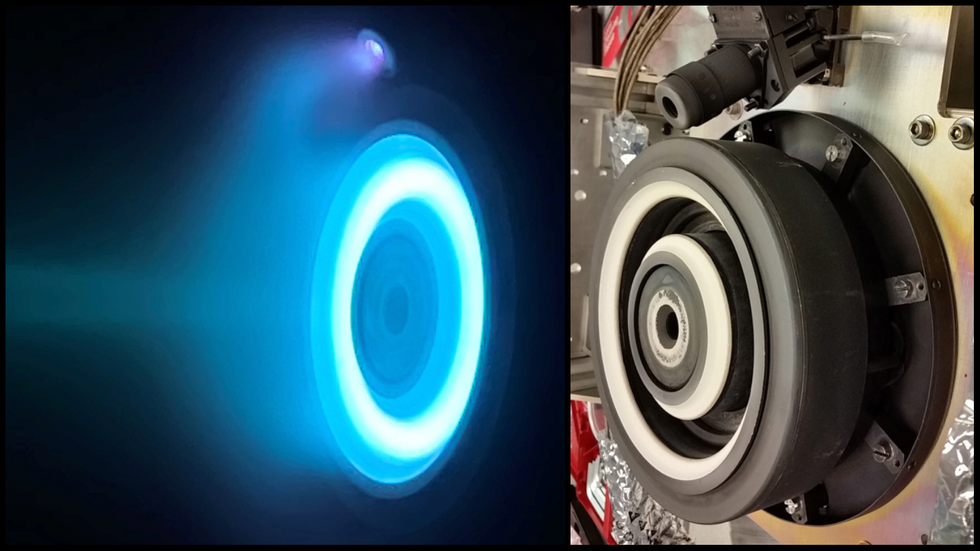 A Hall thruster, four of which will propel the Psyche spacecraft, produces an eerie blue glow during testing [left]. The unit consists of a ring-shaped anode, which has a diameter similar to that of a dinner plate, and a narrow, cylindrical cathode mounted to one side [right].JPL-Caltech/NASA
A Hall thruster, four of which will propel the Psyche spacecraft, produces an eerie blue glow during testing [left]. The unit consists of a ring-shaped anode, which has a diameter similar to that of a dinner plate, and a narrow, cylindrical cathode mounted to one side [right].JPL-Caltech/NASA
Soviet engineers pioneered the use of Hall thrusters in space during the 1970s. And we use four Russian-made Hall thrusters on the Psyche spacecraft for the simple reason that Maxar uses that number to maintain the orbits of their communications satellites.
Hall thrusters employ a clever strategy to accelerate positively charged ions [see sidebar, How a Hall Thruster Works"]. This is different from what is done in the ion thrusters on the Dawn spacecraft, which used high-voltage grids. Hall thrusters, in contrast, use a combination of electric and magnetic fields to accelerate the ions. While Hall thrusters have a long history of use on satellites, this is the first time they will go on an interplanetary mission.
How a Hall Thruster WorksA Hall thruster uses an electron discharge to create a plasma-a quasi-neutral collection of positive ions and electrons-not unlike what goes on in a fluorescent lamp.
The thruster includes a hollow cathode (negative electrode), placed outside the thruster body, and an anode (positive electrode) positioned inside a ring-shaped discharge chamber. If these electrodes were all there was, the power applied to the thruster would just go into making a current of electrons flowing from cathode to anode, emitting some blue glow along the way. Instead, a Hall thruster applies a radially directed magnetic field across its discharge channel.
The electrons emitted by the cathode are very light and fast. So this magnetic field impedes the flow of electrons to the anode, forcing them instead to go in circular orbits around the center line of the thruster. The positive xenon ions that are generated inside the discharge chamber accelerate toward the cloud of circling electrons, but these ions are too massive to be affected by the weak magnetic field. So they shoot straight out in a beam, sweeping up electrons along the way. The ejection of that material at high speed creates thrust. It's not much thrust-equal to about the weight of a few quarters-but applied steadily for months on end, it's enough to get the spacecraft zooming.
We kept costs under control by using hardware from Maxar's standard product line and by minimizing changes to it.
You might think that thrusting around Earth isn't any different from doing so in deep space. There are, in fact, some big differences. Remember, the power to run the thrusters comes from solar panels, and that power must be used as it is generated-there is no great big battery to store it. So the power available to run the thrusters will diminish markedly as the spacecraft moves away from the sun.
That's an issue because electric thrusters are usually designed to run best at their maximum power level. It turns out to be pretty easy to throttle them a little, maybe to about half their maximum output. For example, the Hall thrusters Maxar uses on its communications satellites can run at as much as 4.5 kilowatts when the satellite's orbit needs to be raised. For more routine station keeping, these thrusters run at 3 kW. We needed these thrusters to run at less than 1 kW when the spacecraft neared its destination.
The problem is that efficiency decreases when you do this kind of throttling. In that sense, a Hall thruster is like the engine in your car. But the situation is worse than in a car: The electrical discharge inside a thruster can become unstable if the power is decreased too much. The throttled thruster can even quit firing altogether-like a flameout in a jet engine.
But with some clever engineering, we were able to make modifications to how we run Maxar's thruster so that it could operate stably at power levels as low as 900 W. We then tested our reengineered thruster in facilities at NASA's Glenn Research Center and at JPL to prove to ourselves that it would indeed operate reliably for the full six-year Psyche mission.
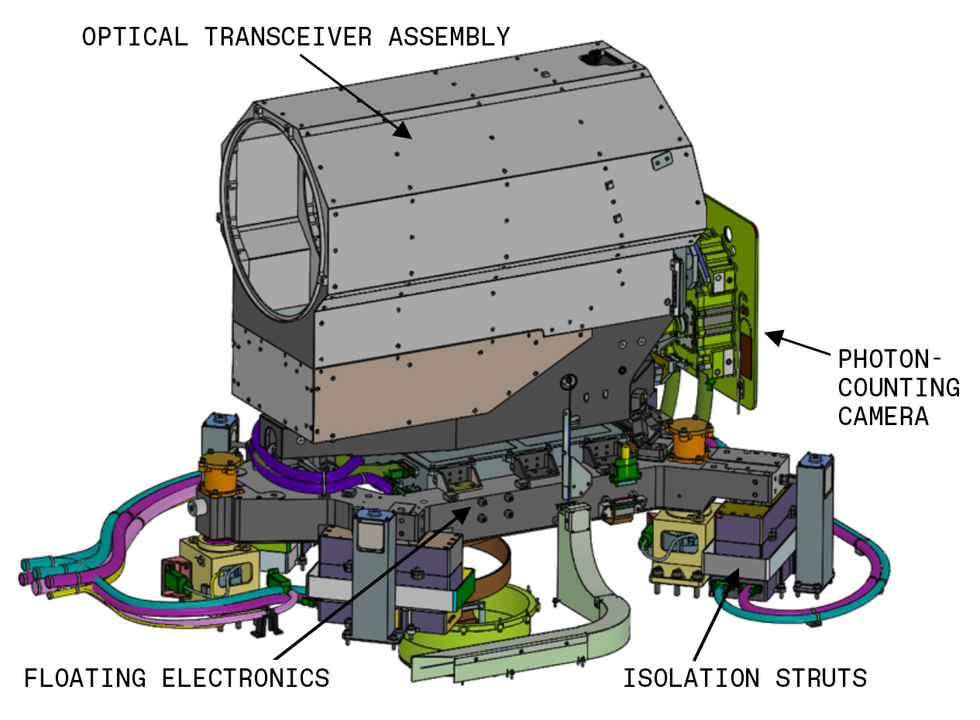 The Psyche mission will test equipment for sending and receiving data optically. This Deep Space Optical Communications (DSOC) system must be pointed with great precision and kept isolated from vibration.JPL-Caltech/Arizona State University/NASA
The Psyche mission will test equipment for sending and receiving data optically. This Deep Space Optical Communications (DSOC) system must be pointed with great precision and kept isolated from vibration.JPL-Caltech/Arizona State University/NASA
The Psyche probe will venture more than three times as far from the sun as Earth ever does. Generating the 2 kW of power needed to operate the spacecraft and fire its thrusters when it reaches its destination requires an array of solar cells large enough to generate more than 20 kW near Earth. That's a lot of power as these things go.
Fortunately for NASA, the cost of solar power has dropped dramatically over the past decade. Today, the commercial satellites that beam television and Internet signals across the globe generate these power levels routinely. Their solar-power systems are effective, reliable, and relatively inexpensive. But they are designed to work while circling Earth, not at the outer edges of the asteroid belt.
When the Psyche mission was conceived in 2013, Maxar had successfully flown more than 20 spacecraft with power levels greater than 20 kW. But the company had never built an interplanetary probe. JPL, on the other hand, had years of experience operating equipment in deep space, but it had never built a power system of the size required for the Psyche mission. So JPL and Maxar combined forces.
The challenge here was more complicated than just dealing with the fact that sunlight at 16 Psyche is so dim. The solar cells on the Psyche spacecraft would also have to operate at temperatures much lower than normal. That's a serious issue because the voltage from such cells rises as they get colder.
When orbiting Earth, Maxar's solar arrays generate 100 volts. If these same arrays were used near 16 Psyche, they would produce problematically high voltages. While we could have added electronics to reduce the voltage coming out of the array, the new circuitry would be costly to design, build, and test for space. Worse, it would have reduced the efficiency of power generation when the spacecraft is far from the sun, where producing adequate amounts of power will be tough in any case.
Fortunately, Maxar already had a solution. When one of their communications satellites passes into Earth's shadow, it's powered by a bank of lithium-ion batteries about the size of what's found in electric cars. That's big enough to keep the satellite running while it is in darkness behind Earth, which is never for much longer than an hour. But the voltage from such batteries varies over time-perhaps from as low as 40 V on some satellites when the battery is deeply discharged all the way up to 100 V. To handle that variability, Maxar's satellites include discharge converters," which boost voltage to provide power at a constant 100 V. These converters were flight proven and highly efficient-ideal to repurpose for Psyche.
The key was to rewire the solar array, lowering the voltage it produced in the vicinity of Earth to about 60 V. As the spacecraft moves away from the sun, the voltage will gradually rise as the arrays get colder until it reaches about 100 V at 16 Psyche. Maxar's discharge converters, normally attached to batteries, are connected to the solar array instead and used to provide the spacecraft with power at a constant 100 V over the entire mission.
This approach incurs some energy losses, but those are greatest when the spacecraft is close to Earth and power is abundantly available. The system will operate at its highest efficiency when the spacecraft nears 16 Psyche, where generating power will be a lot harder. It uses flight-proven hardware and is far more economical than sophisticated systems designed to eke out peak power from a solar array throughout a deep-space mission.
One day the technology being tested may enable you to watch astronauts tromping around the Red Planet in high-definition video.
In addition to the set of scientific instruments that will be used to study the asteroid, the Psyche spacecraft will also be carrying what NASA calls a technology demonstration" payload. Like so many things at NASA, it goes by an acronym: DSOC, which stands for Deep Space Optical Communications.
DSOC is a laser-based communications system intended to outdo current radio technology by as much as a hundredfold. DSOC will demonstrate its capability by transmitting data at up to 2 megabits per second from beyond the orbit of Mars. One day similar technology may enable you to watch astronauts tromping around the Red Planet in high-definition video.
The DSOC instrument has a ground segment" and a flight segment," each of which includes both a laser transmitter and a receiver. The transmitter for the ground segment, a 7-kW laser, will be installed at JPL's Optical Communications Telescope Laboratory, located about 60 kilometers northeast of Los Angeles. A sensitive receiver, one capable of counting individual photons, will be attached to the 5.1-meter-wide Hale Telescope at Caltech's Palomar Observatory, located a similar distance northeast of San Diego.
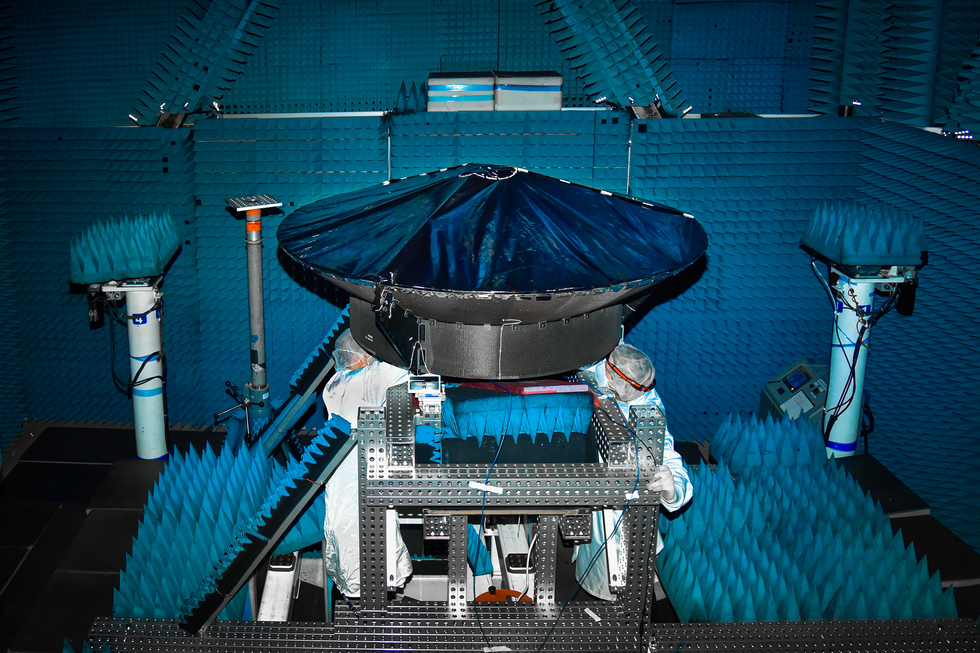 The Psyche spacecraft's high-gain radio antenna, shown here being tested at the Maxar's facilities in Palo Alto, Calif., will provide the data communications throughout the mission.Maxar
The Psyche spacecraft's high-gain radio antenna, shown here being tested at the Maxar's facilities in Palo Alto, Calif., will provide the data communications throughout the mission.Maxar
DSOC's flight segment, the part on the spacecraft, contains the same type of equipment, but much scaled down: a laser with an average power of 4 watts and a 22-centimeter telescope. The flight segment sounds simple, like something you could cobble together yourself at home. In fact, it's anything but.
For one, it needs some rather elaborate gear to point it in the right direction. The Psyche spacecraft itself is able to keep DSOC pointed toward Earth to within a couple of milliradians-about a tenth of a degree. Using built-in actuators, DSOC then searches for the laser beacon sent from the ground. After detecting it, the actuators stabilize the pointing of DSOC's own laser back at Earth with an accuracy measured in microradians.
The flight segment is able to point so steadily in the same direction because it's housed in a special enclosure that provides thermal and mechanical isolation from the rest of the spacecraft. DSOC also uses a long sun shield to eliminate stray light on its laser receiver, with a deployable aperture cover to ensure that the unit remains clean.
During DSOC operations in space, the spacecraft cannot use its thrusters or gimbal its solar arrays, which would introduce problematic movements. Instead, it will keep its attitude fixed solidly in one direction and will use its star-tracking system to determine what that direction is. The constraints on what the spacecraft can do at these times is not an impediment, though, because DSOC will be used only for tests during the first year of the mission, while traveling to just past the orbit of Mars. When the spacecraft reaches 16 Psyche, it will transmit data back to Earth over a microwave radio link.
Having emerged from nearly a decade of planning, and having traveled for more than three years, the Psyche spacecraft will finally reach its target in early 2026. There will no doubt be plenty of tension in the air when controllers at JPL maneuver the spacecraft into orbit, waiting the many minutes it will take signals to be returned to find out whether all went well in this distant corner of the asteroid belt.
If all goes according to plan, for the following two years this communications-satellite-turned-space-probe will provide scientists with a close-up look at this odd metallic world, having already demonstrated an advanced optical system for high-data-rate communications. These achievements will have been a long time coming for us-but we expect that what is learned will be well worth the many years we've put into trying to ensure that this mission is a success.